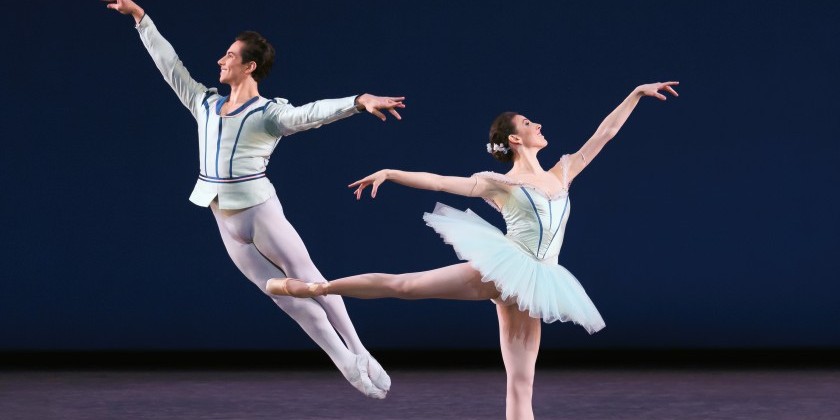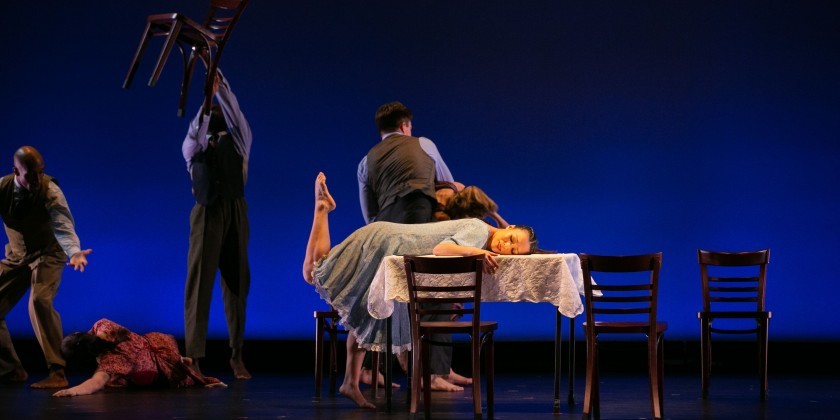IMPRESSIONS: Alonzo King LINES Ballet’s Soulful "Deep River" at Lincoln Center

Choreography: Alonzo King
Original Music: Jason Moran, Lisa Fischer
Music: Maurice Ravel, Pharoah Sanders, Kamalakanta Bhattacharya, James Weldon Johnson & J. Rosamond Johnson
Lighting Design: Jim French // Costumes: Robert Rosenwasser // Sound Design: Philip Perkins
Vocalist: Lisa Fischer
Pianist: Jason Moran
Dancers: Maël Amatoul, Babatunji, Adji Cissoko, Madeline Devries, Theo Duff-Grant, Lorris Eichinger, Shuaib Elhassan, Joshua Francique, Ilaria Guerra, Maya Harr, Marusya Madubuko, Tatum Quinónez
Venue: Rose Theater at Lincoln Center
Dates: February 22 - 24, 2024
A first draft of the history of the COVID era is being written on artistic platforms everywhere nowadays, as contemporary musicians, visual artists, dramatists, and filmmakers are presenting telling works made during, and decidedly impacted by, the pandemic. But it’s on the concert dance stage, perhaps, that the grave era can be most vividly documented. Think about it: what clearer way to illustrate the COVID constraints we all experienced than via the art form that trades in human body movement, spatial relationships, physical energies, and the structured passing of time.
As I watched this February’s New York premiere of choreographer Alonzo King’s 2022 ensemble work Deep River, at Lincoln Center, I was struck by an odd sense of separation despite its abundance of movement. The 65-minute work is performed by 12 stunning dancers of the San Francisco-based Alonzo King LINES Ballet, and two musicians — the Grammy Award-winning vocalist Lisa Fischer, who sings in a corner down-stage-right, and Kennedy Center Artistic Director for Jazz, Jason Moran, who plays piano down in the orchestra pit, enhancing recorded tracks of instrumental music and natural sounds.

A program note explains that Deep River was created over a two-year period during which the dance company worked in quarantined “bubbles” in studios, outdoor grassy areas, and a desolate Arizona desert. The piece grew from King’s “fanatically positive” attitude, and he set it to spiritual music of Black, Jewish, and Indian traditions to represent the power of “inspiration” during difficult times. And that’s exactly what I saw onstage: physical and emotional isolation, amid a shared, fervent determination to keep moving.
Overall, the soulful work feels like one continuous dance. Its 13 episodes, demarcated in the program by their different musical accompaniments, transition seamlessly from one to the next, and are built of similar movement vocabulary. King’s troupe is appropriately named, as his contemporary-ballet choreography is characterized by thrilling lines — long, linear movements of the limbs that reach far out into space, with an exciting, often yearning, quality. When arms extend overhead, down, sideward, or diagonally, they make straight lines, not the soft curves of classical ballet ports de bras. Even when they reach behind the body, they cut razor-straight back from the shoulder. And big leg extensions develop skyward, while elbows, knees, or wrists may bend into sharp right angles that lend a neat, punctuating precision.

Josh Francique, Lorris Eichinger, Maël Amatoul (top), and Babatunji Johnson (right) in Alonzo King LINES Ballet’s Deep River; photo by Richard Termine
But all of that strict linearity is leavened by constantly rounding, arching, or tipping spines, and when impelled by a movement impulse from the torso, an elongated limb often traces a curved pathway. Most remarkable, however, is the non-stop fluidity of the movements, which proves both compelling and confusing. While always interesting and unpredictable, the choreography lacks phrasing. The movements flow easily, but don’t combine into discrete statements with meaningful peaks, starts, or end points. Structurally, one feels a disconnect between the variegated musical score, and the busy, continuous dancing that seems to sail atop the sounds, albeit in common emotional spaces.
The greater disconnect, however, is felt among the dancers. Though beautifully crafted as a mix of solos, duos, trios, and small and large group passages, the dancing feels internally-motivated throughout. Much of the time, the dancers are spread out across the stage, distanced from one another, and each moving separately and differently within their own private spheres. Even when they come together spatially we don’t feel their connection to one another; we see the physical relationships between their bodies, but their movements continue to feel independently initiated, and we don’t see them become emotionally affected by one another.

The sole exception is what musical theatre audiences would call the “11 o’clock number.” In that coveted spot, just before the ensemble finale, Babatunji danced an impassioned solo to Fischer’s powerful rendition of "Lift Every Voice and Sing," commonly known as the Black National Anthem. The emotional link established between the dancer and the vocalist made for stirring drama that stood in stark contrast to the tenor of the rest of the evening.
In addition to traditional pieces — including the African-American spiritual “Deep River” and a “Kaddisch” by Maurice Ravel — the work’s score features original music by both Moran and Fischer. While effectively atmospheric, it seemed to grow in volume and intensity as the evening progressed such that the recorded tracks’ bass vibrations and the engulfing big washes of sound started to give me a headache. But to be fair, perhaps it wasn’t just the music.

Shuaib Elhassan and Lorris Eichinger in Alonzo King LINES Ballet's Deep River; photo by Richard Termine
About half-way through the performance, a man began yelling out from the balcony. As he persisted, others started yelling back, and a brouhaha ensued. The music stopped, the curtain descended, and we all waited until “security” arrived and quelled the disruption. After a few minutes, the curtain went up and the performance resumed. So perhaps my discomfort was partially stress-induced. In any event, I want to extend kudos to all the performers for how impressively they picked-up where they had left off — in the middle of an ensemble section — and proceeded as if nothing had happened. They broadcast King’s message “loud and clear”: under difficult circumstances, just keep moving.














